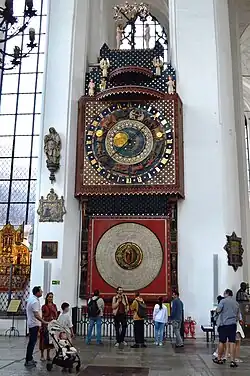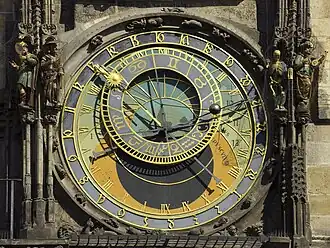Gdańsk astronomical clock

The Gdańsk astronomical clock is a fifteenth-century astronomical clock in St. Mary's Church, Gdańsk, Poland, restored in 1990. It was the largest such clock in the world at the time of completion.
Description
The clock's dials show the time and date, phase of the Moon, the position of the Moon and Sun in relation to zodiac signs, and a calendar of saints. Adam and Eve ring the bell on the hour, and at noon, a procession appears that features Adam and Eve alongside the Three Kings, the Apostles, and Death.[1]
History
The clock was constructed between 1464–1470 by Hans Düringer.[2][3] Standing at 14 metres (46 ft) tall, upon completion, the clock was the largest in the world.[4] Falling into disrepair in the 16th century, it stopped functioning in 1554. It was evacuated to the Vistula Fens during World War II. In 1983, local historian Andrzej Januszajtis appointed a committee with the goal of restoring the clock, which was reactivated on 9 May 1990. It was restored in 2018 to 2019.[5][6][7]
References
- ^ DK Eyewitness Guide: Eastern and Central Europe. Dorling Kindersley Ltd. 2012. p. 211. ISBN 9781405393515.
- ^ Bujak, Adam (2007). Polish Cathedrals. ISBN 9788360292372.
- ^ The Newcomen Bulletin. Issues 158-169. p 14. Newcomen Society (Great Britain) 1994
- ^ Bousfield, Jonathan; Salter, Mark (2009). The Rough Guide to Poland. ISBN 9781848360648.
- ^ Januszajtis, Andrzej; Nietopiel, Aleksandra. "ZEGAR ASTRONOMICZNY". gdansk.gedanopedia.pl. Retrieved 23 July 2025.
- ^ "Bazylika Mariacka. Słynny zegar astronomiczny odnowiony, ale czekają go kolejne zabiegi". gdansk.pl. 13 November 2019. Retrieved 23 July 2025.
- ^ Moritz, Katarzyna (28 July 2018). "Rekonstrukcja zegara astronomicznego w bazylice Mariackiej". trojmiasto.pl. Retrieved 23 July 2025.
